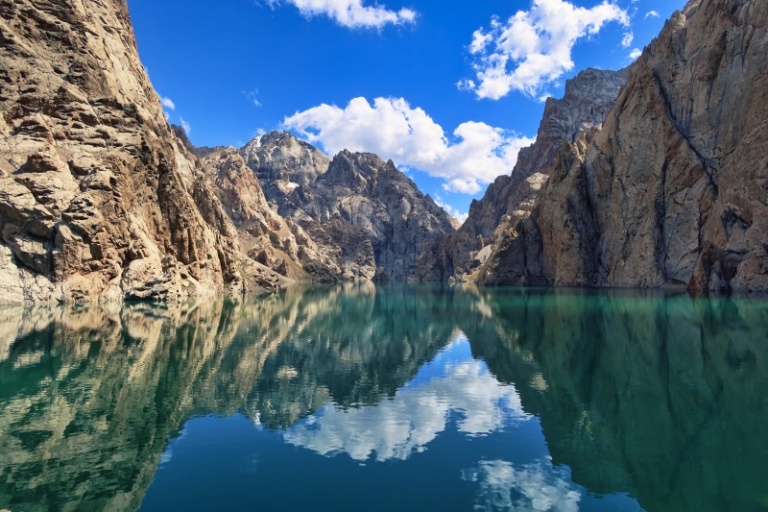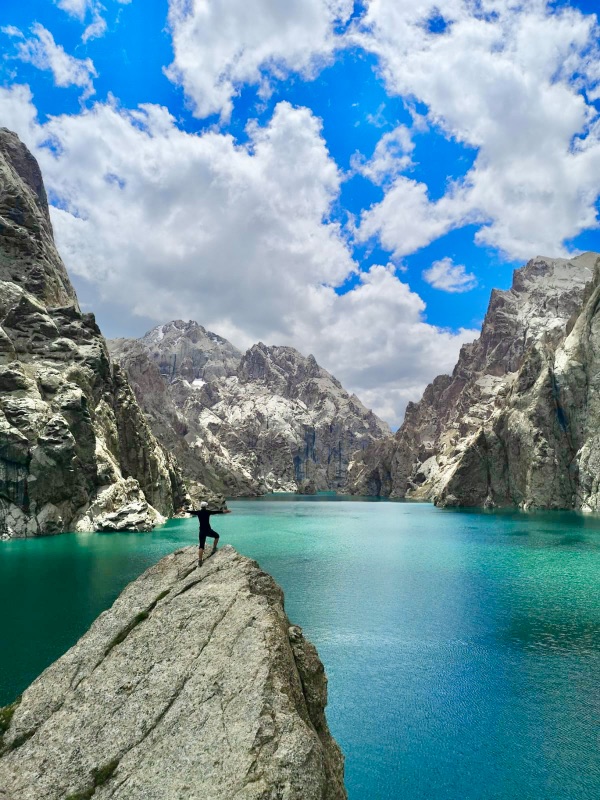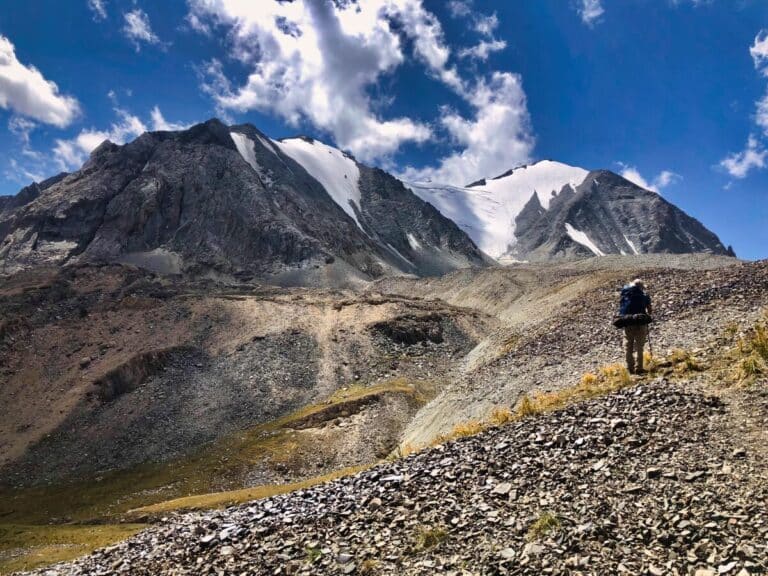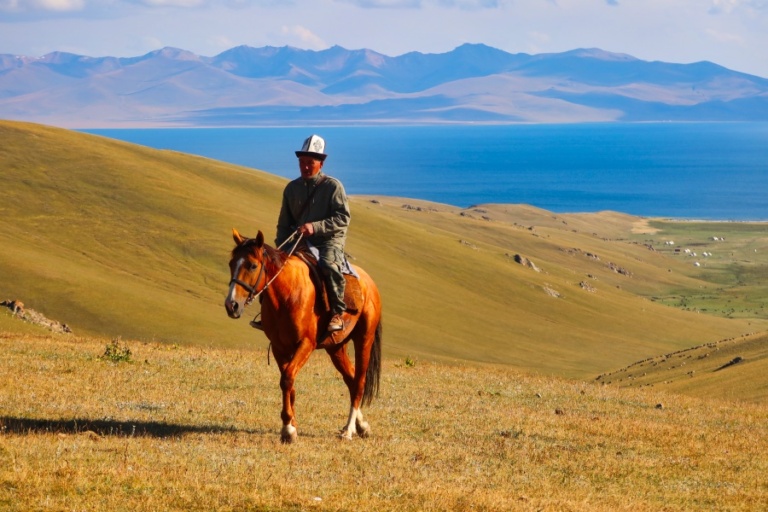Kyrgyzstan Horseback Riding: Essential 2024 Guide
Going on a horse trek is one of the most popular things to do in Kyrgyzstan and for good reason!
Not only is Kyrgyzstan jaw-droppingly beautiful, with no shortage of places to hop on a horse and go riding, but horses are an essential component of Kyrgyz culture. By going on a horse trek, you get to take part in that culture.
Want to go horse riding in Kyrgyzstan? Of course, you do! Let’s get you ready. Read on for our guide to Kyrgyzstan horseback riding.
Kyrgyzstan Travel Resources
- Start here: 14 Awesome Things to Do in Kyrgyzstan
- Getting there: search for flights to Kyrgyzstan
- Guidebook: pick up a Bradt Kyrgyzstan guidebook
- How to get around: rent a car to get around Kyrgyzstan
- Travel insurance: get travel insurance for your trip
- Money: get a Wise travel card to save big time in Kyrgyzstan
- Tours: check out the best Kyrgyzstan tours
Why Go Horse Riding in Kyrgyzstan
Kyrgyzstan is THE place to go horseback riding.
Why? To put it simply, because horses = Kyrgyz culture. There’s simply no better way to experience Kyrgyz culture than through a horse trek (obviously paired with sleeping in a yurt).
As the Kyrgyz people are traditionally nomads, horses have been essential for transportation, work and recreation. Even today, many Kyrgyz families maintain a strong connection to horses, using them for transportation, herding, and participating in cultural events.
As such, Kyrgyz people learn to ride horses from a very young age (we’re talking toddlers here) and can usually master a horse from the age of 6 or 7.
This, paired with the absolutely stunning beauty of the country, makes one perfect horse trekking destination.
Want to go hiking in Kyrgyzstan? Read: 10 Epic Kyrgyzstan Hikes + Essential Tips
Do You Need Experience to Go Horse Trekking in Kyrgyzstan?
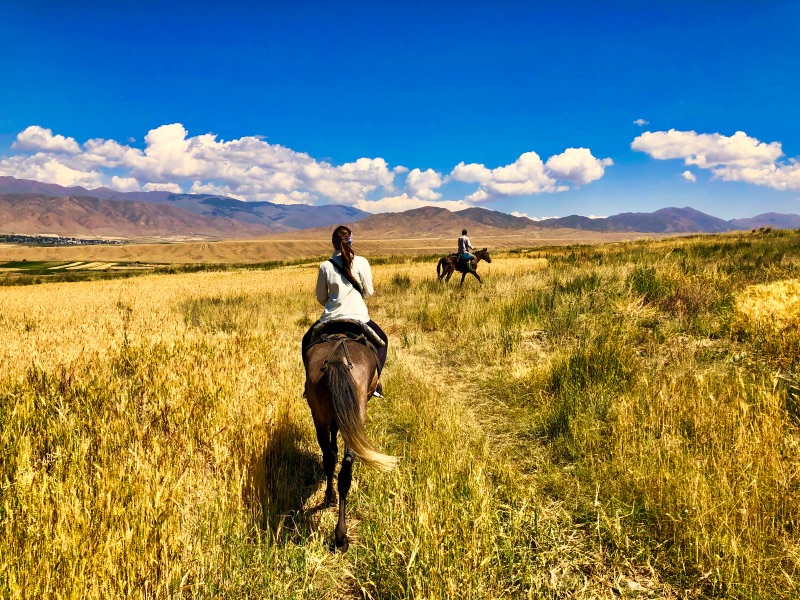
Nope, you do not need any experience to go horse riding in Kyrgyzstan.
As we’ve mentioned, the Kyrgyz are expert horse masters and are used to guiding tourists with no experience.
They’ll ensure you’re paired with a well-trained horse and you’ll have a competent guide for the entire trip. Your guide will give you some instructions on how to handle the horse, communicate with it and navigate.
So long as you listen to your guide’s instructions and don’t act irresponsibly, you’ll have a great time, even with no prior experience.
As a note of confidence, we had zero horse riding experience and still had a successful 3-day horse trek in Kyrgyzstan.
Related: Ala Kul Lake Essential Guide
Horse Riding Basics
Is Kyrgyzstan Horseback Riding Safe?
Horse riding in Kyrgyzstan is safe, so long as you follow instructions and act appropriately.
Here are some tips to keep you safe for Kyrgyzstan horseback riding:
Never walk behind a horse. Horses have two blind spots, one of which is just behind their tail. Even a gentle horse may kick at an unexpected sound or movement coming from their blind spot. Give at least a 2m berth behind a horse.
If you’re nervous, tell your guide beforehand. They’ll keep an eye on you or keep close to you for the trek. They can also ensure you get a more docile horse.
Don’t gallop unless you’ve discussed this with your guide. We’ve heard so many stories of tourists becoming overconfident, falling off their horses and injuring themselves.
If your horse is trying to go rogue, stay calm and firmly in command. Speak to your guide if you need assistance.
Travel insurance, as always, is essential. Sadly, tourists get injured every year when horseback riding in Kyrgyzstan. We use and recommend SafetyWing. Trust us, we’ve used a lot of travel insurance and they really are the best.
How to Organise a Horse Trek in Kyrgyzstan
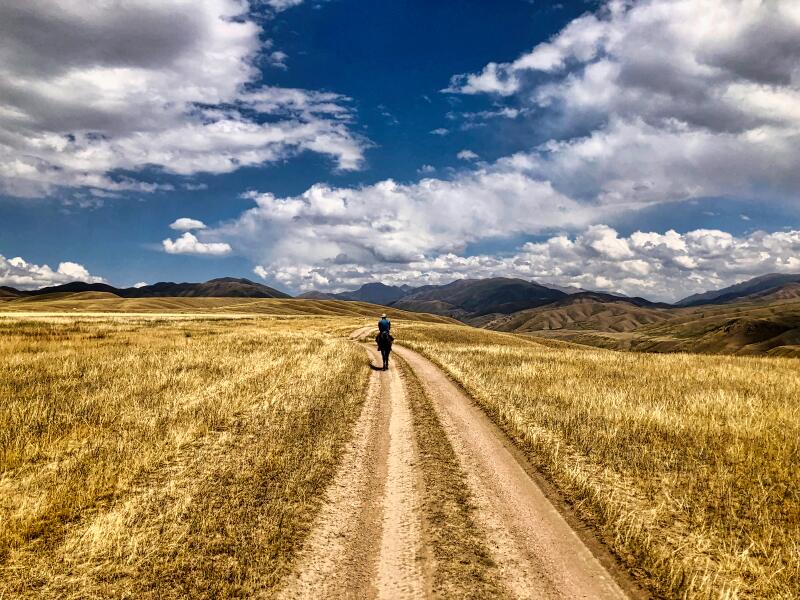
It’s extremely easy to organise a horse trek in Kyrgyzstan. Pretty much every place you go will have someone milling about offering to take you on a ride.
You can either organise a horse trek independently, or through an agency.
Read next: How to Visit Stunning Kol Tor Lake
Organising a Horse Trek Independently
Organising a horse trek independently is pretty self-explanatory. Most yurt camps (which are everywhere) will have someone with horses that can take you out on a horse ride, whether for a few hours or a few days.
If you just want to ride for a couple of hours, this is an easy, and popular, option. Speak to the individual about the ride, negotiate and hop on!
This is a popular option if you want to ride for a couple of hours at popular spots like Kel Suu or Tash Rabat.
You can also organise a multi-day horse trek independently. For example, from Kyzart, you can organise a ride to Song Kul Lake. However, the cost of doing it this way isn’t usually any cheaper (and a lot more work).
The only thing to note here is that language may be an issue, as English is not widely spoken in Kyrgyzstan.
Organising a Horse Trek Through a Tour Company
If you want to go on an overnight or multi-day horse trek in Kyrgyzstan, we recommend organising your trip through a tour company.
There are several logistics to sort out (i.e. food and accommodation) and the cost is usually pretty similar to if you organise it independently.
Most towns of any size will have at least one CBT office and one tour company that can organise a horse trek.
When organising, be sure to choose a reputable tour operator. They should have a valid license, well-trained horses and good equipment. We used Jailoo Tourism in Kochkor and were really happy with them.
If you want to organise things in advance, you can always organise a horse trekking tour online. This highly-rated tour to Song Kul lasts for 3 days, while for the truly adventurous, there’s this excellent 5-day option in the Alay Mountains.

Kyrgyzstan Horse Trekking: What It’s Like
The ‘standard’ Kyrgyzstan horse trek is around 2 to 3 days. 3 is probably the most popular (we have no data on this) but they can range anywhere from a one-day ride to one week.
You’re not allowed to go on your own, so you’ll always have a guide. This is a young man with some English who will teach you the basics before you head off.
Just like humans, each horse has its own personality! When we did our horse trek to Song Kul Lake, I was given the disobedient horse in the group. Zandy was lucky and had the docile horse, while mine went rogue at every opportunity.
Read: The Ak Suu Traverse – The Essential Hiking Guide
On a multi-day horse trek, you’ll probably ride from 4 to 6 hours per day. You’ll finish at a yurt camp, where you’ll stay for the night.
The horses will rest and you have some downtime to wander, read, take photos, explore – you get the gist.
You’ll sleep in a yurt, which is a great experience. They’re basic but cosy. Expect a mattress, bedding and if you’re lucky, a fire. There will not be any showers and the toilets are usually basic (sometimes squatters).
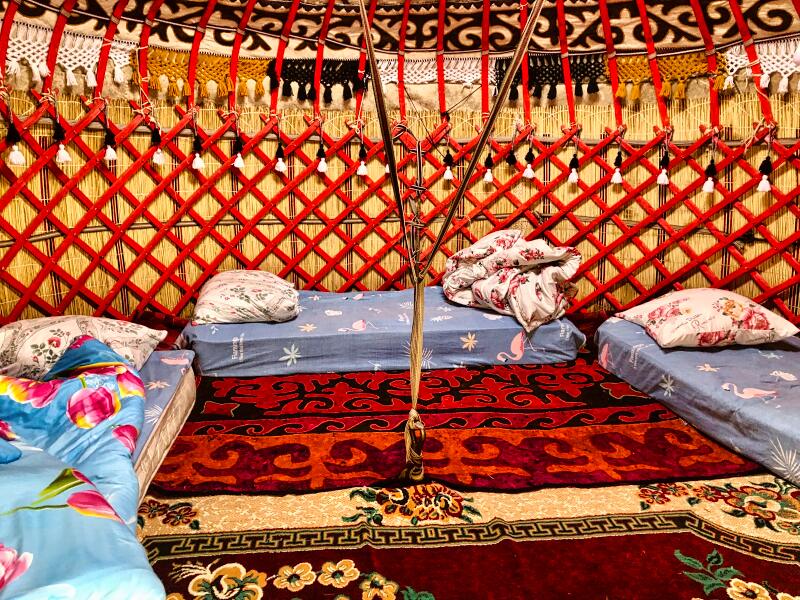
Dinner is served in a communal yurt. You sit on the floor around a low table. Like the yurts, the food will also be basic: bread, jams and plov (a very popular Central Asian dish that is like a pilaf with vegetables and meat) are the essential dishes.
In the evenings, we played games in the communal yurt. We taught our guide to play Yahtzee, and although he spoke very limited English, he learned quickly and dominated us all!
Important: your body will hurt, especially your butt and back. It takes a surprising amount of core strength as well! That’s why, if you’re not experienced, we say no more than 3 days for a horse trek.
How Much Does It Cost To Go Horse Riding in Kyrgyzstan
Fortunately, horseback riding in Kyrgyzstan is not that expensive.
Generally speaking, if you organise things independently, it costs around 1500 KGS per horse per day. You’ll also have to pay for the guide, which is around 2500 KGS. However, if you go in a group, that cost is shared.
If you’re going for an overnight or multiple days, then you need to factor in your accommodation and food. It’s around 2500 KGS per person for a yurt stay with breakfast and dinner.
If you’re going via a tour company, expect to pay 12,000 KGS per person for an all-inclusive 3-day / 2-night trip.
the Best Time to Go Horseback Riding in Kyrgyzstan

The best time to go horseback riding in Kyrgyzstan is from June to September, during Kyrgyzstan’s summer.
During this time, you’ll have the best chance of good weather (although the weather in Kyrgyzstan’s mountains is notoriously unpredictable, so anything can happen!).
The summer is also when the Kyrgyz people go to the yurt camps in the jailoos (high summer pastures. Outside of summer, the yurt camps won’t be open, making logistics very difficult.
Where to Go Horse Trekking in Kyrgyzstan
You can pretty much go horse trekking anywhere in Kyrgyzstan, as both yurt camps and tour companies offering horse riding are prolific.
Here are a few particularly noteworthy places to go horse trekking in Kyrgyzstan.
Song Kul Lake
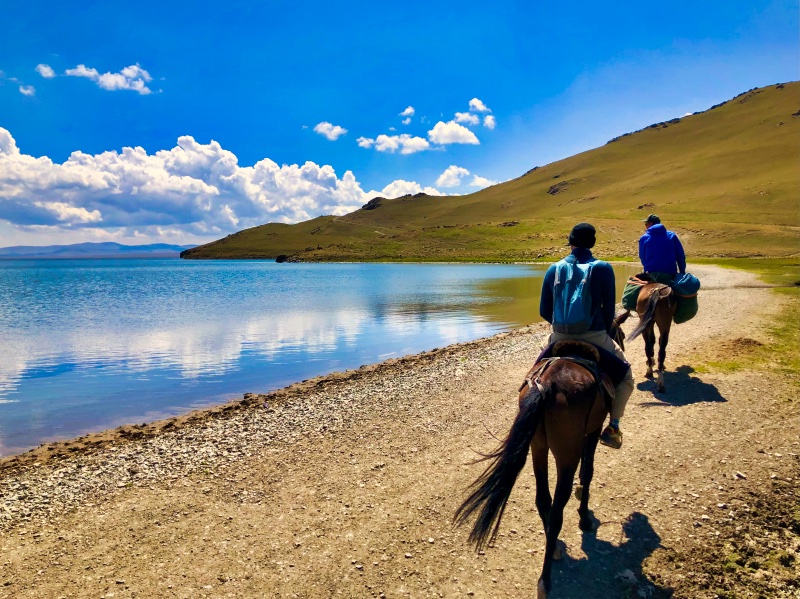
Now, of all the places to go horseback riding in Kyrgyzstan, Song Kul Lake is #1. It’s the most popular place in Kyrgyzstan for horse trekking.
Song Kul is a beautiful, high-altitude lake surrounded by an expansive jailoo (summer pasture).
It’s a huge lake, so there are many different itineraries and yurt camps you can choose from. The most popular itinerary is 3 days, which we think is pretty perfect.
We chose a route that took one day to reach the lake, one day to ride around the lake and another to ride back.
On the first and last days, we rode over high mountain passes. We really loved this route and would highly recommend it. Riding around the lake was particularly peaceful and our favourite day on the entire trek.
Read our complete guide on How to Visit Song Kul Lake
Kel Suu Lake

Kel Suu Lake is fast becoming one of Kyrgyzstan’s most sought-after destinations. And it’s no wonder why: this lake is simply stunning.
Most people trek into Kel Suu Lake from the yurt camps in the Kok Kiya Valley, but you can also ride in.
There are many yurt camps set up in the Kok Kiya Valley, all of which offer horse riding. Just speak to any of the owners and negotiate a price for the half-day trip.
You need a permit to visit Kel Suu, read how to get one here.
Read: Kel Suu Lake Essential Travel Guide
Kol Ukok
Kol Ukok is a relatively unknown lake near Kochkor (the same place you organise a horse trek to Song Kul). Whilst you can also hike to Kol Ukok, it’s also a great spot to go horseback riding.
The typical route is 2 days: one day to reach the lake and another to return. There are yurt camps, so you don’t need to bring camping gear.
Tash Rabat

Tash Rabat, an ancient Silk Road caravanserai, is another popular place to go horseback riding in Kyrgyzstan.
Tash Rabat is one of Kyrgyzstan’s only Silk Road attractions and is nestled in the hills near China.
The most popular horseback riding trip at Tash Rabat is a whole-day round-trip ride to Chatyr Kol Pass at 4,100m.
For the truly keen, you can turn this into a 2-day trip by descending to Chatyr Kol Lake and spending the night in a yurt camp there.
You can organise a day trip to Chatyr Kol Pass from any of the yurt camps at Tash Rabat.
For an overnight at Chatyr Kol Lake, speak with the CBT in Naryn. You’ll also have to get a permit to visit the lake. Read how to get a permit here.
What to pack for Kyrgyzstan Horse Riding
If you’re going on a fully organised horse trekking tour, you don’t need to bring a lot with you. Here are the essentials:
If you plan on doing any camping, here’s our complete packing list of what we always bring with us into the mountains.
Disclaimer: This post contains affiliate links. This means that if you buy or book anything through them, we’ll earn a small commission at no extra cost to you. This helps us run this website and create comprehensive guides to help you get off the beaten track. We only recommend products and/or services that we use ourselves and trust.



